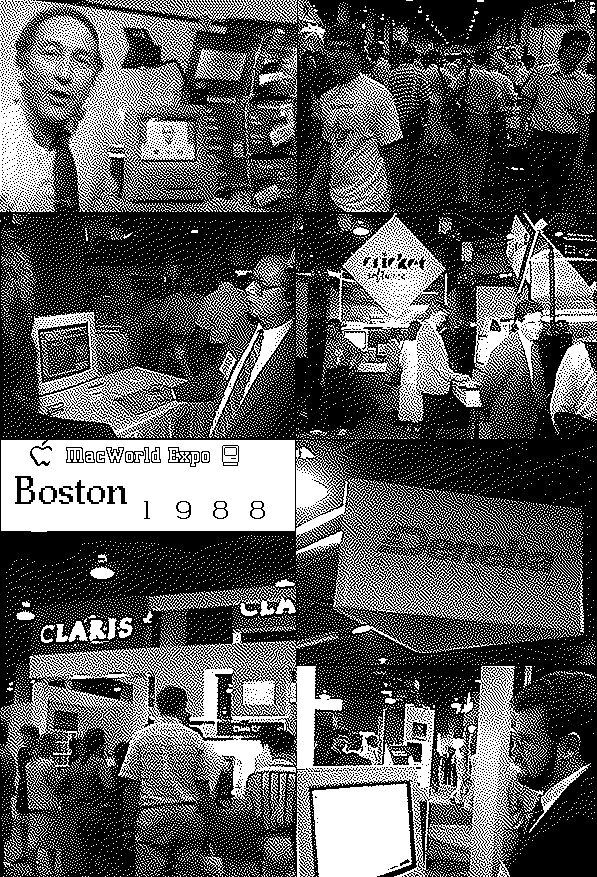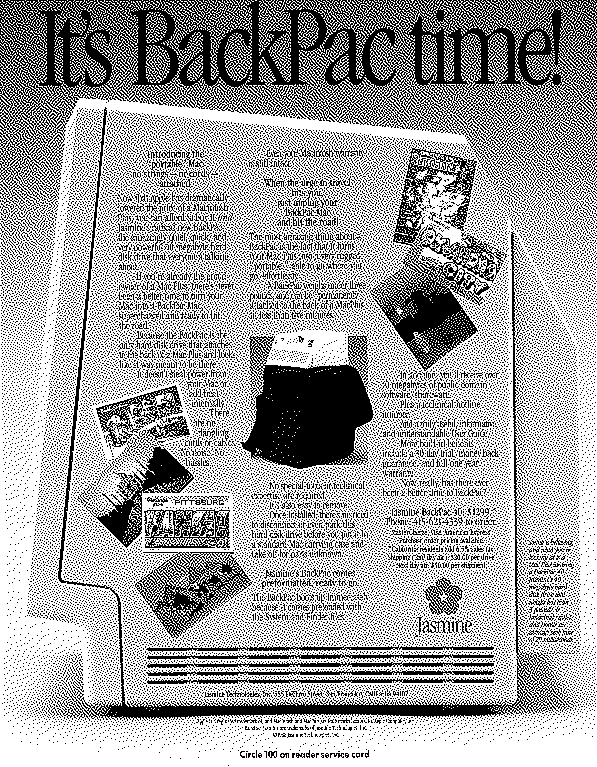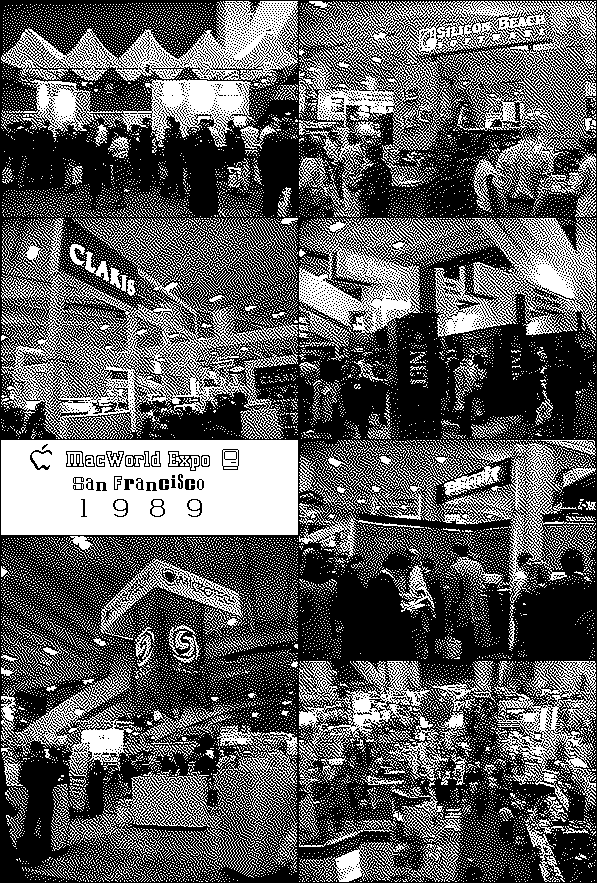 MacWorld Expo 1988 Boston
MacWorld Expo 1988 Boston
Trade Show

Cricket, Deneba, Claris, and other booths
Dates: August 11-13 1988
Locations: Bayside Exposition Center, World Trade Center
Exhibitors: 400
Attendees: 40,000 (estimated)
Keynotes
John Sculley, who showed the famous “Pencil Test” 3D rendering vignette of a cursor who escapes from the screen of a Mac. The video was rendered on a Macintosh II and involved 20 members of Apple’s Advanced Technology Group.
Quotes
The weather was hot and the show was ‘dull’. There were lots of people in suits not buying anything. There was nothing new or revolutionary. The same could not be said about the food at expo parties, we had seafood every night!
As we prepare to wend out way through the multisite monstrosity
known as the Macworld Expo, it is interesting to look back and think that it
was a mere four and a half years ago that Apple introduced the Macintosh as
the computer of the future. […] When we hit the floors of the first Boston expo in August 1985, things were better, but business America was still snickering over the death throes of the Macintosh Office. […] And now the balance of power in the micro industry has shifted to the point where Apple is running at the front of the pack. […] Sculley, Gassee, Yocam and the rest of the Apple gang might not fuel that same feeling of wonder and fun many of us had when we got our first Macs in 1984, but they are moving the company in a direction that all but guarantees it will be around in 1994 and beyond.
Apple
Apple showed off its new Apple Scanner, with its bundled software package Ofoto. I remember ordering and using one of these not long after 1988, and Ofoto was indeed an an amazing step forward. The hardware was also well-designed, offering classic “Snow White” styling. If I recall correctly this was a greyscale model — color was yet to come. What I had no memory of, but that contemporary reporting documents, is that the Scanner had suffered from an 11-month shipping delay — apparently because of software holdups. Rumors that Apple would endorse CAERE’s OmniPage software for OCR turned out to be unfounded, however.
One Apple product which was rumored to appear, but which did not, was a new Mac based on the 68030 chip. Steve Costa, a leader of BMUG, shot down rumors at the meeting immediately preceding the Expo to this effect , including those printed in a front-page article in InfoWorld.
Word Processing
This MacWorld marked the debut of Paragon’s Nisus, at least in alpha form. The word processor was viewed as a further development of their existing text editor QUED/M, with advanced features such as a drawing module, while still maintaining modest (1mb) RAM requirements and good performance (“almost as fast as WriteNow, double the features of MS-Word, yet half the size of FullWrite!”). Though nearly finished as long ago as January of this year, Paragon still wanted to incorporate a thesaurus and other features, so November was the now the target shipping date. “Perhaps,” write an excited visitor from Sweden, “this is THE word processor!”
Meanwhile WriteNow version 2 was demonstrated but not shipping.
Desktop Publishing
Springboard introduced Publisher, a $200 package for those looking something easier (and cheaper) than PageMaker.
Multimedia
Was Macworld Boston 1988 the first year for Macintosh multimedia? That’s the impression you get reading the coverage of HyperAnimator, an animation system for HyperCard by Bright Star. The public television program Computer Chronicles chose to lead off their coverage of the Expo with a close-up of the software working its magic on a 1-bit digitized avatar of program host Stewart Cheifet. Contemporary articles, such a a mention in InfoWorld, explicitly linked the program to the goals set out in Sculley’s Knowledge Navigator concept video.
At its heart, this technology sought to map MacinTalk-generated speech to a set of pre-recorded face and mouth image, so that a person could seem to be ‘speaking’ arbitrary text without the need to provide full-motion video. In its own way, a testimony to the inventiveness of programs and programmers. before computers became powerful enough to handle more sophisticated forms of full-motion video.
Software with a more direct connection to the eventual direction of the industry was MacroMind’s VideoWorks, which we discussed last year in Boston. For 1988 Marc Canter introduced VideoWorks Professional. MacWEEK described the improvements as full-color paint; color palette controls; new animation tools; MIDI; 24-bit color support; and on-line help. Just as interestingly, a $700 CD-ROM disc with stock movies, sounds, and animation sequences. Does any copy of this early optical media survive, I wonder?
Speaking of CD-ROMs, MacWEEK produced an entire article on the intersection between these optical devices and the burgeoning world of large-scale content — a market sector that would eventually be called Shovelware. With Apple recently having released software support for the High Sierra data format, both Mac and non-Mac discs could be shown off on the show floor. One Mac-specific title of note weas Brøderbund’s Electronic Whole Earth Catalog (shown in pre-release form):

(See the User Groups section below for information on BMUG’s PD-ROM.)
Math Software
Mathematica was demonstrated publicly, together with a math typesetting program called Milo. The latter was described by Wolfram as a “WYSIWYG electronic math scratchpad” — perhaps based on the same engine as Mathematica, but without the requirement for the user to master that more complex program’s language.
Spreadsheets & Databases
FoxBase 1.1
Graphics
Silicon Beach Software showed off Digital Darkroom, a greyscale photo editing app that had suffered long delays due to growing pains at the company. Silicon Beach also showed SuperPaint 2.0, its competitor to the recently-unbundled MacPaint.
Speaking of original Apple-branded software, MacDraw II, the long-delayed revision to the first object-oriented drawing program, was finally shipping. But it faced new competitors: Canvas from Deneba and the oddly-named Draw It Again, Sam from Aba. Another new entrant was Cricket Paint, a $195 offering that also brought object-oriented and bitmap graphics into one package.
The next step beyond object-oriented drawing programs was clearly Postscript design, and both Adobe’s Illustrator as well as Aldus’ Freehand were on deck to begin a rivalry which would continue until the eventual purchase of Aldus by Adobe. Adobe’s new version, Illustrator ’88, boasted “new features [that] have enabled Illustrator 88 to gain ground against Freehand,” in the words of Macworld editor Jerry Borrell.
Dubl-Click, best known for their clip art collections, threw its hat into the graphics ring with Wet-Paint.
Moving from 2-D to 3-D, Silicon Beach also showed Super3D, a real-time color animation program for the Mac II.
Productivity
Aldus demonstrated Persuasion, a “Desktop Presentation Program” as the genre was then known. This may have been the first time the product name was announced — Macworld spoke of an “unnamed” competitor to Microsoft PowerPoint and Cricket Presents. . As Aldus president Brainerd noted:
Asked about the host of other recently announced Macintosh presentation packages, Aldus President Paul Brainerd acknowledged that the market would not support all of the products, but said he was confident that Persuasion would be one “of the few that will come to the forefront.”
Utilities
A utility package which made a big impression at the show was “Screen Gems.” This $80 disk was published by Microseeds, and included four programs:
Switch-A-Roo by Billy Steinberg, an FKEY for changing monitor settings.
ColorDesk by Paul Mercer, which which promised to “Replace the boring desktop pattern with a full-color picture of whatever you like.”
Dimmer, a screen saver for the Mac II.
Olduvai showed MultiClip, which evolved from a Clipboard replacement to something more akin to a Scrapbook upgrade. Interestingly, this was complemented by ClipShare, which allowed clipboards to be shared across an AppleTalk network. (Intriguingly, ClipShare was listed as vaporware in a print volume as late as 1990…)
Peripherals
One of the first PostScript clones made its debut in the form of the Jasmine DirectPrint and QUME CrystalPrint (two printers based upon the same Casio engine with a liquid-crystal shutter.) A RISC-based processor and 3MB of memory meant it outperformed the LaserWriter by three to four times, but it wasn’t shipping till October. Cost was about $4,000, and observers from BMUG noted that it was “good looking.”
The TrueVision NuVista — a card I remember using well — turned heads on the show floor with its 32-bit color, an exotic feature in 1988. “Does everything you could imagine,” raved BMUG members, “including setting resolution from software. 32-frame virtual screens, way ahead of everything else.” One thing I didn’t remember about it was it’s high price: $6,000.
Mass Micro — an name I had always associated with hard drives — was apparently also showing off true-color and video capture cards as well at this MacWorld.
Jasmine was on the show floor with their BackPac for the SE or Plus. This device attached to the back of the compact Mac, and was available in sizes ranging from 20mb to 100mb.

Oddly, an accompanying 2400-baud modem plugged into the side. Have to try and dredge up a picture of this:
The company will also offer an optional 2,400-bps modem called TalkBac, which can be installed inside any BackPac drive.
FWB was also on-site with their Hammer series of drives, including the PocketHammer, at a mere 7x9x3 inches all around. Must be quite a big pocket.
Believe it or not, a Mac-controlled embroidery machine, which could generate patterns from MacPaint files, garnered a lot of attention.
Networking
Farallon, a spin-off of the Berkeley Macintosh User’s Group, showed off version 2.0 of Timbuktu. This screen-sharing software, which functioned as kind of a 1980s version of VNC, was described as an “innovative… AppleTalk-observe/participiate package.” Timbuktu Remote would extend these LAN-based services to the (slow) modem connections that were beginning to link workers to their offices while away from them. Macworld’s Jerry Borrell looked forward to companion products to Timbuktu that would involve distributed processing and advanced groupware. At least one of these actually shipped — “Katmandu”, to be known as ScreenRecorder. Paired with Farallon’s MacRecorder audio hardware, these were all the elements one would need to do what we now call screencasts. Regardless, Borrell exhorted his readers to “plan… to spend as much time as you can at Farallon’s booth at the expo.”
User Groups
BMUG introduced their PD-ROM, a CD-ROM full of public-domain software (what we might today call Shareware.) This represented all two hundred and eight floppies that BMUG had previously sold out of their office and through computer stores.

At $100, BMUG was charging for the cost of duplication and distribution, not the free software on the disc itself — a testimony to the costs of disc production in the 1980s.
BMUG also had their Newsletters on offer, volumes so thick that a visitor described them as “bibles…. the best book of MacWorld!”
Posted in Expos | 1 Comment »
 MacWorld Expo Washington 1989
MacWorld Expo Washington 1989





